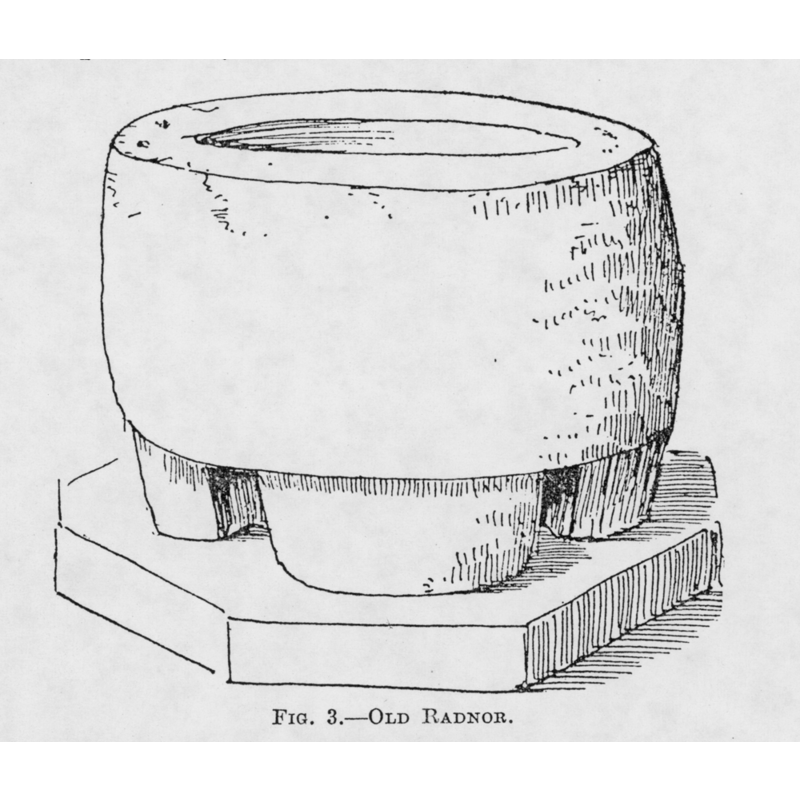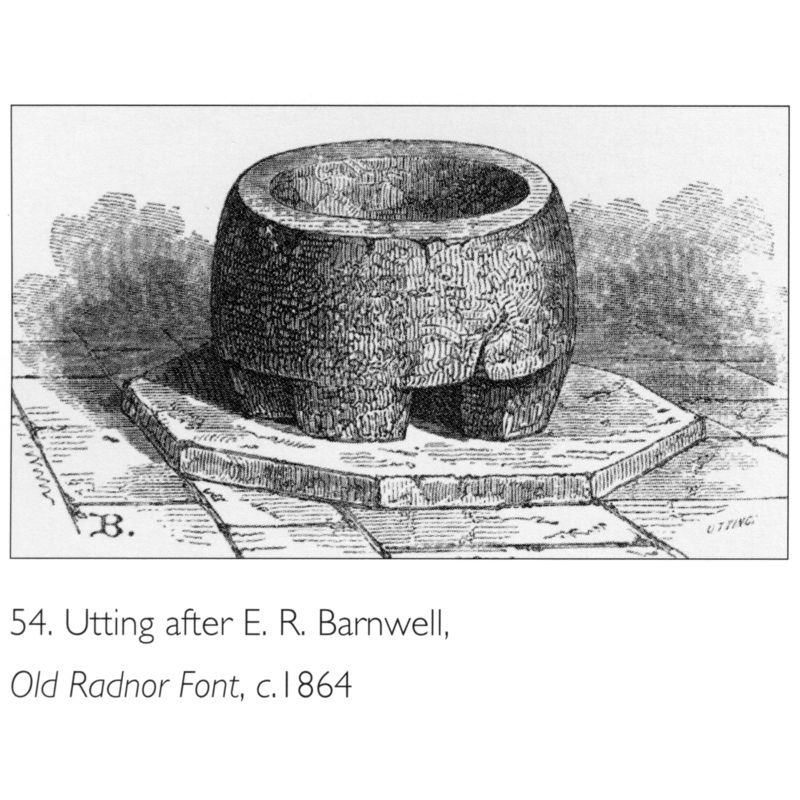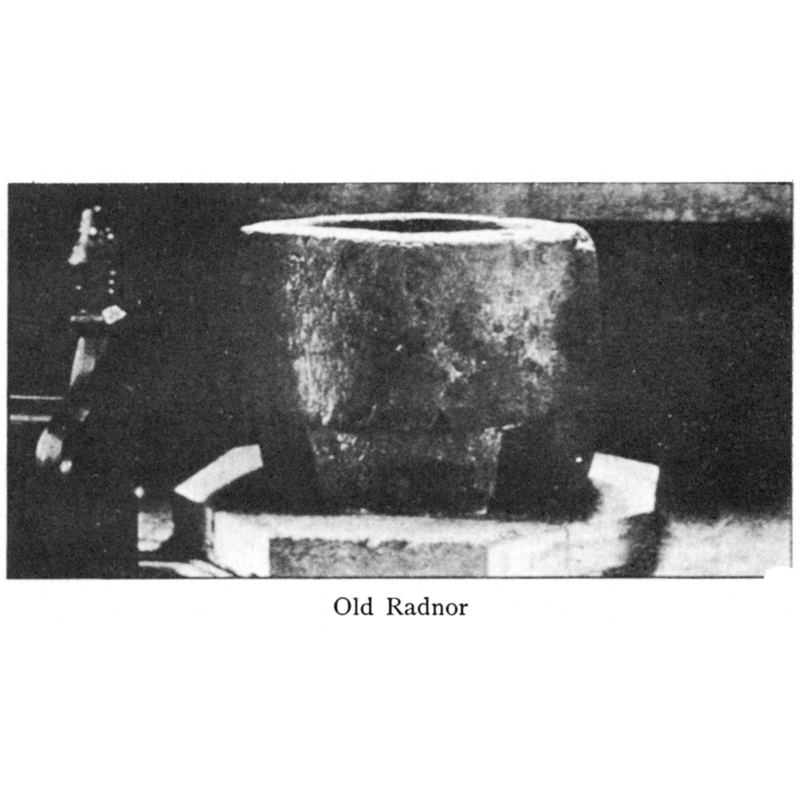Old Radnor / Maes-hyved Hen / Pencraig

Image copyright © Jack Dodge, 2008
Permission received (e-mail of 10 January 2010)
Results: 7 records
view of church exterior - southeast view
view of font
view of font
view of font
view of font and cover
view of font and cover
Copyright Statement: Image copyright © Radnorshire Museum [s.d.]
Image Source: detail of an digital image in Casglu'r Tlysau / Gathering the jewels [www.gtj.org.uk/en/item1/24339] [original source appears to be an undated photograph or postcard]
Copyright Instructions: PERMISSION NOT AVAILABLE -- IMAGE NOT FOR PUBLIC USE
view of font and cover in context
Copyright Statement: Image copyright © Radnorshire Museum [s.d.]
Image Source: digital image in Casglu'r Tlysau / Gathering the jewels [www.gtj.org.uk/en/item1/24339] [original source appears to be an undated photograph or postcard]
Copyright Instructions: PERMISSION NOT AVAILABLE -- IMAGE NOT FOR PUBLIC USE
INFORMATION
FontID: 01029OLD
Object Type: Baptismal Font1
Church/Chapel: Parish Church of St. Ystyffan [aka St. Stephen's]
Church Patron Saints: St. Ystyffan [supposedly a 6th-century saint from a Welsh royal family] / St. Stephen?
Church Location: Old Radnor, Presteigne, Powys LD8 2RH
Country Name: Wales
Location: Powys
Directions to Site: Located off the A44, about 30 km WNW of Hereford, about 8-10 km NW of Eardisley, at the SE edge of the Radnor Forest
Ecclesiastic Region: Diocese of Hereford
Historical Region: formerly part in Radnorshire, part in Herefordshire
Font Location in Church: Inside the church
Century and Period: 8th century, Pre-Conquest
Credit and Acknowledgements: We are grateful to Jack and Mary Dodge, of www.jackmaryetc.com, for their photograph of this font
Church Notes: Bond suggests that "the church itself on its knoll may have replaced some prehistoric temple" -- The CPAT [www.cpat.demon.co.uk] notes: "An early foundation, possibly dedicated originally to Ystyffan and subsequently anglicised to Stephen, the churchyard, the putative early dedication and the font all go to suggest an early medieval beginning. Lands belonging to Old Radnor church were supposedly acquired by the See of Worcester in AD 887 (Howse 1949)."
Font Notes:
Click to view
Noted in Lewis' Dictionary of 1833 and 1849, and in the National Gazetteer of 1868. In Barnwell (1864). Vat-like baptismal font with its lower part cut into four crude feet. Described and illustrated in Tyrrell-Green (1928) as "a very remarkable example of an early font which appears to have been fashioned from a Druidical altar"; later he adds that the font "bears a strong resemblance to altars used in early Semitic worship, and in ealy Christian times seems to have been found handy for conversion into a font by roughly hollowing out a basin in it." Bond (1908) refers to this font as a "remarkable and very large example" of cases in which "the builders were unable to bring accurately to shape" the material they started with. Bond (ibid.) found it striking that so rudimentary an obejct would be so highly polished, and set to wonder about its makers: "One can hardly help speculating that at some Pre-Christian period this great block of stone was found in situ or hard by; that it was naturally nearly circular in form; that the natives gave it a flat top, and cut away its base into the present four legs; and then with incredible patient toil brought it to a high polish; and that it became a sacred stone; perhaps an altar[...]. In later days, probably Pre-Conquest days, the great block was utilised as a font, a cavity being hollowed in the top of it; [...] the cavity was not cut when this polishing took place, for it is very rough. The probability is, therefore, that the cavity was cut in Christian times to adapt the block for use as a font, and that it was left rough as it was intended to line it with lead. There are indeed signs that at some time it actually was lined with lead" (ibid.) Thurlby (2006) comments on the 8th-century date: "that is difficult to substantiate". Noted in the Historic Churches Preservation Trust, Recent Grants [...] 16 March 2006 [www.historicchurches.org.uk] as a baptismal font of the 8th century. The font is now raised on an octagonal plinth. Jenkins (2008) writes: "The tub font is said to date from the 8th century, a misshapen lump of rock, yet eerily scluptural like a work by Henry Moore." Shipton (2012) writes of a visit of a members of the Fforwm Cerrig Cymru/Welsh Stone Forum to Old Radnor: "Inside the church was an old font made of local altered Stanner-Hanter Complex gabbro, it was thought to date from about the C8th [...] The group spent some time inspecting it but a positive identification of its origin was not possible."
COORDINATES
Church Latitude & Longitude Decimal: 52.224936, -3.099585
Church Latitude & Longitude DMS: 52° 13′ 29.77″ N, 3° 5′ 58.51″ W
UTM: 30U 493198 5786061
MEDIUM AND MEASUREMENTS
Material: stone, gabbro (igneous rock) (possibly Stanner-Hanter Complex)
Number of Pieces: one
Font Shape: tub-shaped
Basin Interior Shape: round
Basin Exterior Shape: round
Drainage Notes: no lining
Rim Thickness: 15 - 20 cm*
Diameter (inside rim): 82.5 - 85 cm*
Diameter (includes rim): 112.5 - 115 cm*
Basin Depth: 22.5 - 25 cm*
Font Height (less Plinth): 75 - 77.5 cm*
Notes on Measurements: * [Bond (1985 c1908: 131) and Tyrrell-Green (1928: 19)] [Thurlby (2006: 269) gives 3ft 10in internal diameter]
LID INFORMATION
Material: wood, oak?
Apparatus: no
Notes: flat, thick and round, with metal ring handle; date unknown
REFERENCES
The National Gazetteer: a Topographical Dictionary of the British Isles, London: Virtue & Co., 1868
The Visual Culture of Wales = Diwylliant gweledol Cymru, Cardiff: University of Wales Press, 1998-2003
Barnwell, E.L., "Old Radnor font -- Lyonshall font", 19, Archaeologia Cambrensis, 1864, pp. 146-150; p. 146-150
Bond, Francis, Fonts and Font Covers, London: Waterstone, 1985 c1908
Jenkins, Simon, Wales: Churches, Houses, Castles, London: Allen Lane, 2008
Lewis, Samuel, A Topographical Dictionary of Wales, Comprising the Several Counties, Cities, Boroughs, Corporate and Market Towns, Parishes, Chapelries, and Townships, with Historical and Statistical Descriptions [...], London: S. Lewis, 1833
Shipton, John, "The Building Stones around Old Radnor: 10 September 2011", 9 (March 2012), Newsletter (Fforwm Cerrig Cymru/Welsh Stone Forum), 2012, pp. 18-20; p. 18-19 and fig. 2
Thurlby, Malcolm, Romanesque architecture and sculpture in Wales, Little Logaston, Woonton, Almeley, Herts.: Logaston Press, 2006
Tyrrell-Green, E., Baptismal Fonts Classified and Illustrated, London: Society for Promoting Christian Knowledge: The Macmillan Co., 1928




